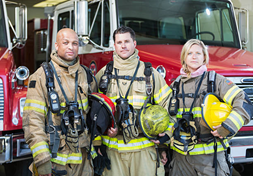
What is the problem?
Females are about 3% of all firefighters. Research suggests higher rates of injury in females. We do not know enough about how females might differ from male firefighters. Knowing these differences can be important so that equipment and how firefighters complete their tasks are both as safe as possible.
The hose drag is an important and common firefighting task. We wanted to know if male and female firefighters move their hips and knees the same way when doing this task. This could help us create ways to avoid injury.
How did the team study the problem?
We wanted to separate body size differences as a reason why male and female firefighters might do tasks differently. Eight pairs were made, each with one male and female of the same height and weight. Videos of the firefighters picking up and dragging the hose were used. We used a computer program to measure the movement in their knees and hips. Notes were made about which foot the firefighters stepped with first and if they put the hose over their shoulder or under their arm.
What did the team find?
We found that males used their hips more to lift and females lifted more using their knees. It is better to lift with your knees. This might mean that females are using better lifting techniques. Females usually have less muscle mass than males so females may use their legs more to try and improve safety. We found that every male stepped with their right foot first and put the hose over their shoulder. There was no pattern of movement for the females. This could be good if it leads to less stress on certain muscles, but it might lead to less accuracy.
How can this research be used?
This study tells us that male and female firefighters perform the hose drag task differently. Males lift more with their hips. This means they are at risk of back injury. Informing males to protect their backs when they lift might be helpful in avoiding injury. Females use their legs while lifting. By making their legs stronger, females should improve their safety and how they do the task.
Cautions
We do not know why the firefighters made the movements they did or whether it was the best choice. This study used a small number of firefighters and may not represent all firefighters. We did not know if the firefighters were left-handed or right-handed, which may have affected how they moved. This is one piece of information that can help to understand how to improve firefighter training. We still need more information to make decisions on programs.
Reference: Nickel, C., MacDermid, J., & Sinden, K. (2019). A Case-Control Evaluation of Body Kinematic Differences Between Male and Female Firefighters. Manuscript in progress.
Funding Sources: CIHR (FRN: 114112); MoL (FRN: 13-R-027)
